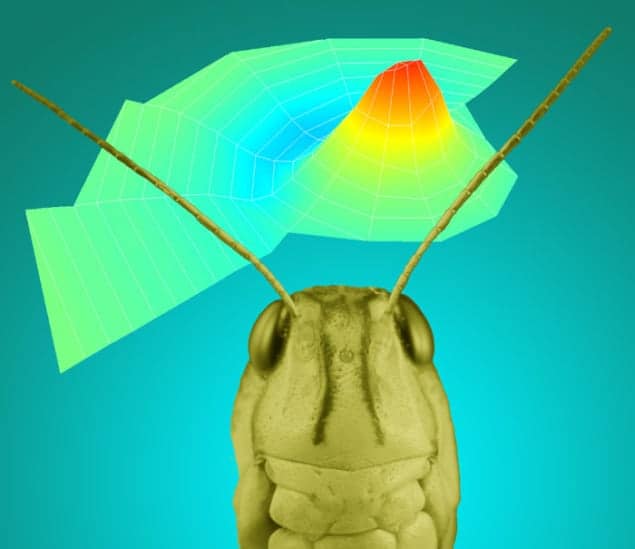
Locusts have a highly integrated and miniaturized hearing system that bears little resemblance to either the human ear or an electronic microphone. That is the conclusion of researchers in the UK who have done a detailed study of how the insects detect and process sounds. The insect’s hearing system, which makes use of a nanostructured eardrum to discern between high- and low-frequency sounds, could provide inspiration for the development of tiny microphones or systems for processing human speech.
Locusts and other insects are too small to accommodate the kind of highly developed hearing systems that are found in some larger animals. Mammals, for example, first capture sound with an eardrum, then amplify vibrations through middle-ear bones, and finally transmit these to the cochlea, which functions as a frequency analyser.
Locusts need to distinguish between different frequencies for survival: low-frequency sound from other locusts and high-frequency sound from foes such as bats. But these insects “do not enjoy the luxury of such a complicated, large and biologically expensive-to-build apparatus”, says Rob Malkin of the University of Bristol, who was involved in the study. Instead, their ears are much simpler and all of the necessary functions are performed by the eardrum. “So far, such eardrum behaviour has been observed in locusts only,” he says.
Tiny vibrations
The Bristol team was led by Daniel Robert and it used a laser Doppler vibrometer to analyse how a locust’s eardrum membrane responded to incoming sound waves that were produced by a loudspeaker. The membrane is kidney-shaped and has two points on its inner surface, where mechanoreceptor cells – neurones that respond to mechanical stress – are attached in two different groups.
The researchers scanned the laser over the surface of the membrane, where they measured tiny picometre (10–12 m) out-of-plane vibrations induced by the sound waves. They found that for low-frequency sounds, the membrane vibrated in such a way that both groups of cells were mechanically excited. But high-frequency sounds managed to excite one group only – meaning that the eardrum effectively behaved like “a basic, but efficient, frequency analyser”, says Malkin.
The researchers then studied the membrane’s nanostructure using a focused ion-beam mill. The results reveals that waves caused by low-frequency sounds will travel completely across the membrane, where low-frequency-sensitive neurons attach to the membrane. But high-frequency waves will only travel half that distance, stopping at the attachment point of high-frequency neurons. This confirms that locusts are able to distinguish between high and low frequencies, says Malkin. The ion beam also revealed that the membrane had internal fluid-filled chambers, which could dampen sound depending on its frequency.
Energy localization
The team also found that the energy density contained in the travelling wave was amplified by as much as 56,000 times as it travelled across the eardrum. This means that the shape of the membrane is such that acoustic energy is collected by the surface of the eardrum and then focused towards the receptor cells.
Such energy localization has so far only been observed in locusts, says Malkin. However, the team’s analysis suggests that the process is remarkably simple and it is possible that the same mechanism might also exist in mammalian ears. If that is the case, it would be an exciting new function of the mammalian ear.
Indeed, James Windmill at the University of Strathclyde in the UK believes that the research could “provide insight into more complicated ears such as our own”.
Tiny but tough microphones
The research could also lead to the development of microphones and sensors that are much smaller and simpler, yet less fragile, than the existing technologies. “Insects are generally robust to mechanical shocks, much more so than larger vertebrate species,” says Robert. “We are currently looking at making detectors that encapsulate such features, and display the desirable characteristics of locust and other insect ears.”
Ron Miles of Binghamton University in the US, who was not involved in the research, believes that locust ears could also offer inspiration for creating new signal-processing technologies. “This research demonstrates that some of the frequency-dependent signal processing could be performed efficiently through careful structural-acoustical design of the pressure-sensing microphone diaphragm,” he says. “The fact that this approach has been successfully used in a fairly simple insect auditory system shows that the idea has considerable merit.”
One specific application could be in converting complex waveforms of speech signals into written text.
The study appears in the Journal of the Royal Society Interface.
- Members of the Institute of Physics can read more about the wonders of locusts in the November 2013 issue of Physics World magazine, which shows how these creatures’ ability to avoid crashing into things could lead to collision-avoidance sensors for cars. The magazine is available online or by downloading the Physics World app onto your iPhone, iPad or Android device, available from the App Store or Google Play, respectively.



